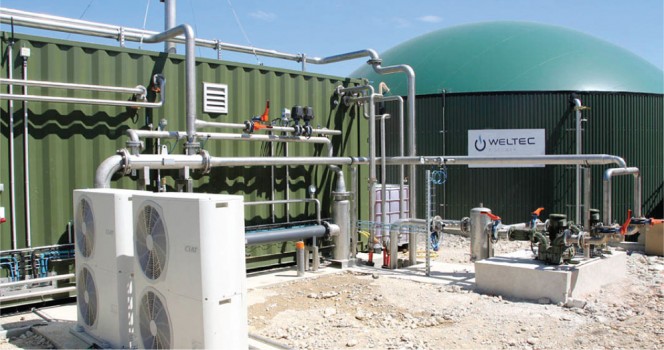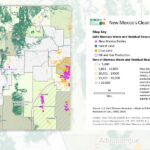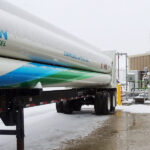BioCycle September 2015
Londonderry, New Hampshire: Stonyfield Yogurt Puts AD To Work
In 2006, Stonyfield Yogurt built an anaerobic digester to pretreat its high strength wastewater prior to discharge into the Town of Londonderry sewer system. “The town did not require Stonyfield to put in a digester, but it did require that we pretreat our wastewater,” explains Lisa Drake, Director of Sustainability Innovation at Stonyfield Yogurt. “The Town of Londonderry discharges to the City of Manchester’s sewers, and has a limit on its loading rate. We evaluated a variety of options to lower the BOD, COD and TSS [total suspended solids] of our wastewater, and ultimately decided to install an anaerobic digester.”
The pretreatment system, supplied by ADI Systems, includes two equalization tanks to buffer incoming wastewater, a 1.75 million gallon low rate digester receiving about 200,000 gallons/day on average, and an aerobic polishing tank. The wastewater is comprised primarily of washwater and chemicals from cleaning equipment, ingredients from production tanks (e.g., when switching yogurt flavors), and off-spec batches of yogurt. Retention time in the digester is about nine days. “The equalization tank discharges into the bottom of the digester, and then digested effluent is drawn off the top and flows to the sequential batch reactor in batches four times a day,” says Drake. “The sludge bed in the digester varies in concentration. When it reaches a certain amount, solids are removed by a contractor, who brings mobile dewatering equipment. A resource management company blends the dewatered solids with wood ash to create a fertilizer.”
The digested effluent is treated in the aerated polishing tank in a batch process that takes about six hours. “It works in a mix cycle, where it fills, aerates, settles and then decants the effluent,” Drake explains. “We are achieving 99 percent removal of BOD and COD.” Biogas is combusted in a boiler that heats the digester (temperature in the digester averages about 90°F). During the extreme cold of winter, natural gas has to be used in the boiler as well to keep temperatures in the mesophilic range in the digester.
Franche-Comté, France: Biomethane Plant On Line
The Longchamps biomethane plant in the Franche-Comté region in eastern France went on line in August, continually supplying 70 cubic meters (m3)/hour of renewable natural gas (RNG) to the French gas distributor, GrDF. A 400,000-gallon anaerobic digester supplied by WELTEC BIOPOWER (WelTec) GmbH processes about 4,600 tons/year of swine and dairy manure, 1,400 tons/year of potato starch and 660 tons/year of cereal silage. “The majority of the biogas is produced from the potato starch,” notes Craig Wong of WelTec. Retention time in the digester is 75 days. A screw press is used to separate solids and liquids in order to reduce the liquid volume that needs to be stored,” adds Wong. All material is used on the farm where the digester is located.
Biogas is conditioned using a three-stage separation procedure (also supplied by WelTec), where methane is separated from CO2, water vapor and other constituents using special polymer membranes. Methane yield is about 99 percent. The upstream compression of the separated methane provides the needed pressure for feed-in to the natural gas grid, eliminating the need for an additional compressor. “France has a feed-in tariff for RNG of about 11 euro cents/kWh thermal,” says Wong. “This equals more than 32 Euros/MMBTU (about US$36/MMBTU). By feeding in 70 m3 of RNG/ hour they gross about 1,848 Euro a day (US$2,062) in RNG sales alone. Current natural gas prices are 4 to 5 euro cents/kWh thermal (about 14 Euros (US$16.60)/MMBTU).
Amsterdam, Netherlands: Proposed Rules Could Thwart Biogas Injection
One of the Netherlands’ largest producers of biomethane says proposed changes to national gas quality rules would make biogas injection into the pipeline “virtually impossible.” Attero, a waste management firm, which operates a biogas injection plant in Groningen, says the new rules could shut down existing biogas plants and prevent new projects from getting off the ground. If implemented, the rules would require the calorific value of gas fed into the grid to be no more than 1.5 percent lower than the gas in the receiving pipeline, averaged over 12 months. Increasing the calorific value of biomethane imposes the extra cost of adding a higher-octane gas such as propane, for example, says Attero.
The calorific value of natural gas in Dutch pipelines is escalating due to falling production of relatively low quality gas from the Groningen field being compensated for by increased imports of higher quality gas from Russia and other countries. This rise poses a problem for the biogas industry. “Sustainable green gas cannot compete with fossil natural gas,” notes Attero. The company, and Suiker Unie, another large Dutch biomethane producer, propose maintaining the current calorific value requirements, which offer more leeway.
Toronto, Ontario: Biogas Procurement Policies
Ontario must change its procurement system if additional large biogas facilities are to be built in the province, says Jennifer Green, executive director of the Canadian Biogas Association (CBA). The current process makes it difficult for biogas developers to compete with wind, solar, water and biomass projects when the provincial government issues requests for proposals for renewable energy, she notes. The Independent Electricity System Operator (IESO) manages procurement of electricity in Ontario. Two of its programs involve renewable energy. One is the Feed-in Tariff (FIT) for projects generally with a capacity of 500 kilowatts (kW) or less. It offers a limited number of 20-year contracts that pay a premium rate for electricity sold to the provincial grid from renewable generating sources. The other, known as Large Renewable Procurement (LRP), is for projects generally above 500 kW and involves a complex, two-stage process.
The IESO is midway through an LRP intended to approve renewable energy projects — up to 300 MW of wind, 140 MW of solar, 75 MW of waterpower and 50 MW of bioenergy. The agency qualified only two bioenergy projects, totaling 37 MW, for the next stage of the process. These projects would generate electricity through incineration of biomass. No biogas projects are on the list. The CBA explains that four biogas project operators entered the earliest stage of the procurement process. The IESO qualified one for the next stage but the operator didn’t pursue it further. Green calls the situation disappointing but not surprising: “Very few biogas developers are looking seriously at the LRP.”
Furthermore, notes Green, the current FIT rules, in effect, limit biogas development opportunities to projects of less than 500 kW, and even that part of the program has been “slow moving.” The CBA proposes a third tier be built into the FIT program that would include projects between 500 kW and 10 MW. Biogas projects bigger than 10 MW “are not common, making competition with other renewable technologies, including biomass, very challenging,” she says. Other CBA suggestions: IESO reserve the 13 MW of capacity remaining from the current bioenergy allocation, after the 37 MW of biomass on the list, for biogas projects; and IESO modify the procurement process to reduce the cost of participating. “The current expense is beyond the financial capability of many biogas developers, particularly when they have limited confidence in the evaluation process or timeliness of contract awards,” Green explains. The CBA will consult with its members to propose improvements to the IESO for the next LRP to help enable greater biogas opportunities.
Golden, Colorado: NREL HelpS Federal Agencies Meet Renewables Target
Under a goal established in March by Executive Order 13693, “Planning for Federal Sustainability in the Next Decade,” federal agencies have until 2025 to get at least 30 percent of their electricity from renewable sources. Executive Order 13693 also mandates that all new federal buildings, beginning in 2020 or later, be designed to reach net-zero status by 2030. Currently, only 8.8 percent of electricity used by the federal government comes from renewable sources, according to the U.S. Department of Energy (DOE). On a per agency basis, this amount fluctuates wildly, from as little as 0.2 percent at the Postal Service to as much as 105 percent at the Environmental Protection Agency, notes an article by the National Renewable Energy Laboratory (NREL), part of DOE. The executive order did not include funding, so federal agencies can tap into private sector financing options such as power purchase agreements (PPAs) with utilities. To help comply with the mandate, NREL developed a new tool, REopt (Renewable Energy Optimization), an energy-planning platform that shows agencies which renewable energy projects make the most economic or technical sense for a building or site, and helps them prioritize how to meet energy targets.
How well federal agencies are progressing toward their goals is measured and reported annually to the Office of Management and Budget. In their quest to use renewable energy, federal agencies can’t spend more than they would if they purchased conventional utility power. The Department of Defense (DOD) uses far more energy than any other federal agency and also relies on renewables the most, according to the NREL article. About 1.5 million MWh of DOD’s energy came from renewables in Fiscal Year 2013, but that accounted for only 6.2 percent of the 30 million MWh the agency used that year. The Navy’s goal is to procure or produce a gigawatt of renewable energy by the end of this year.
Albany, New York: 83 Microgrid Awards Winners Announced
Eighty-three communities across New York State will receive awards of approximately $100,000 each to support community microgrid projects, announced New York Gov. Andrew Cuomo in July. The awards were granted as part of Stage 1 of the NY Prize microgrid competition to support community-based power under Cuomo’s Reforming the Energy Vision strategy (see “Anaerobic Digest,” July 2015). The competition was administered by the New York State Energy Research and Development Authority (NYSERDA), and generated proposals from more than 130 cities, villages, towns and municipalities.
Award recipients include local governments, community organizations, nonprofit entities, for-profit companies and municipally owned utilities. All winning projects must serve multiple customers, including at least one “critical infrastructure” customer, such as a hospital, police station, fire station or water treatment facility.
Over the next six to eight months, the Stage 1 award winners will assess the technical, operational and financial feasibility of their proposed community microgrid. These studies will uncover the most favorable technical configurations, as well as immediate opportunities for energy efficiency and distributed energy installations. Once the studies are completed, communities can compete for further support from NY Prize or pursue the distributed energy resource opportunities uncovered in their feasibility study.
The 83 communities receiving support for feasibility studies may choose to apply for detailed engineering support in Stage 2 of the competition. NYSERDA will also work with third parties and the State’s utilities to provide access to existing clean energy programs and services for communities that do not receive NY Prize support. In Stage 3, the final competition stage, NY Prize funding will be made available for project construction; both Stage 2 and 3 will involve a cost-share.













